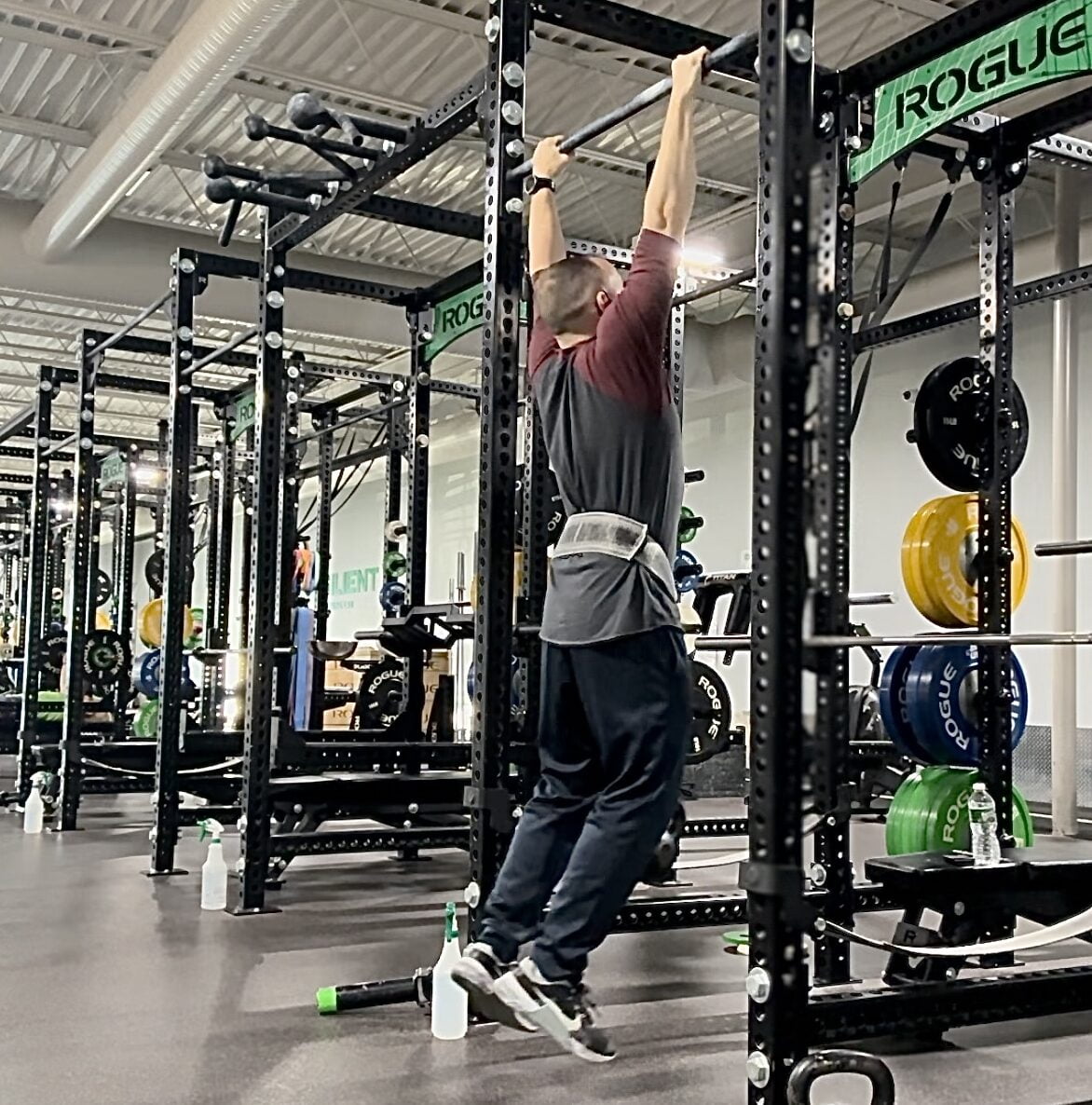Dr. Will Murtagh is a performance physical therapist and writer who helps Fitness Athletes elevate their fitness and train pain-free.
Achieving your first strict pull-up is a challenging feat for CrossFitters. It is the ultimate test of upper body strength to move from a dead hang position and elevate your body weight up to move the chin above the plane of the pull-up bar.
Every day, CrossFitters perform strict pull-ups in their respective gyms as a part of the workout of the day (WOD). But, if you are new to CrossFit, building the foundational strength needed to get your first strict pull-up can be challenging. It is possible, though, in less time than you may think with the right program, motivation, and coach behind you.
As a CrossFit coach for over ten years and now a practicing licensed Physical Therapist who specializes in working with CrossFitters through my 1:1 Pain-Free Performance Program, I see that many avid CrossFitters are going about getting their first strict pull-ups the wrong way. You may fall into this category and feel like you are putting in the hard work you think is required but never seem to progress.
I am here today to tell you that there is a better option for you to finally achieve your first strict pull-up so you can ditch the bands and start feeling like you are moving past your current capabilities.
In this comprehensive guide, we will dive into the benefits of achieving your first strict pull-up, how to perform the movement correctly so you can avoid shoulder injuries, and uncover the pull-up progression I have used for myself and my clients so you have everything you need to start crushing your CrossFit WODS.
How To Get Your First Strict Pull-Up For CrossFit
One of the main reasons that CrossFitters struggle with achieving their first strict pull-ups is that the ratio of their upper body strength to their body weight needs to be higher. This ratio, called relative strength, compares your strict pull-up strength to your body weight.
Unfortunately, for people who come into CrossFit from other strength backgrounds, you may have too much muscle mass on your body, and therefore, the upper body strength needed to perform a handful of strict pull-ups will be challenging.
On the other hand, you may be new to training and need more strength through the shoulder girdle to lift your chin above the pull-up bar. Regardless of your situation, the fact remains that to achieve that elusive first strict pull-up, a great foundation of strength through the arms, core, and shoulder blades is required.
Benefits of Achieving Strict Pull Ups
Strict pull-ups have several benefits not just for CrossFit Athletes but anyone looking to improve their fitness.
Upper Body Strength: The strict pull-up is the final destination for building motor control in the “pull” pattern and is the best way to develop vertical pulling strength. The “pull” pattern is one of the six foundational movement patterns humans should master to optimize their fitness and stay injury-free. Once motor control is achieved, you can work towards building muscle endurance and then maximal contractions by using additional loads.
Shoulder Stability: Building the foundational strength needed to achieve your first strict pull-up is an excellent way to prevent shoulder injuries because it is the best option for fortifying the shoulder. As you move through a pull-up progression, you are strengthening not only your arms for pulling but also the muscles around the shoulder blades, which are critical for keeping the shoulders healthy and moving well.
Structural Balance: In most people who train today their focus will be on movements like the bench press, strict press, the Olympic lifts and other more social media worthy movements. But, they forget to prioritize the back muscles and muscles of the upper back that keep the shoulder joints balanced structurally. When they are not structurally balanced, you can see compensations in movement that can predispose you to shoulder injuries as well as limit your performance if you don’t have full access to the full range of motion.
Competition: Some people want to get into the gym to build their fitness, look great and feel even better which is awesome. But, if you consider yourself one of many CrossFit Athletes in search of becoming the fittest in your gym, the region and ultimately the world thant developing your strict pull ups will be critical. If you are a beginner with these endeavors, then it is even more important as building your strict pull-up strength is a necessary step before moving to advanced movements like kipping or butterfly pull-ups.
How To Perform A Strict-Pull Up
Follow these steps to perfect the strict pull up
Starting position: Assume a standing position under the pull-up bar and, using the lower body, jump to grab the bar with roughly a shoulder-wide grip and allow the rest of the body to be in a dead hang position with the core and back muscles engaged in a hollow position but not producing any movement just yet. Depending on your pull-up variation, the grip can be underhand (supinated grip) or overhand (pronated grip).
Ascent: Without the use of momentum, retract the shoulder blades down and back as if you were to put them in your back pockets. At the same time, use the muscles of the upper back and Latissimus Dorsi to pull the elbows down towards your body to elevate the body upwards.
Finish Position: To complete the repetition, continue pulling upwards until the chin is clearly over the top of the bar in a controlled manner.
Return Position: Once the chin has moved past the top of the bar, allow the shoulder blades to reverse direction and the arm to extend fully until they have moved back down into a full range of motion where they will be able to initiate the next repetition or allow for a safe dismount from the bar.
Muscles Involved In The Pull Up
Performing a strict pull-up movement pattern is a coordinated effort of muscle activation between several upper body muscles. Let’s dive into what they are so you can understand which ones must be optimized to get you to your first strict pull-up.
Latissimus Dorsi: the largest muscle in the body located on the sides of the backside of the body and creates the “V Taper” that many fitness enthusiasts and CrossFit Athletes are after.
Trapezius: The Trapezius muscles are located on the backside of the body as well but reside at the upper back. The Trapezius muscle group is composed of the Upper Trapezius, Middle Trapezius, and Lower Trapezius. They are responsible for shoulder blade movement and vital for your shoulder blades’ health. But, when overactive, the Upper Trapezius can cause neck and shoulder issues.
Rhomboids: The Rhomboids reside in between the shoulder blades and the spine. They play a pivotal role in retracting the shoulder blades during the ascent of the strict pull-up and controlling the body towards the floor after the movement is completed.
Biceps Brachii: The Biceps assist in stabilizing the shoulder in the front of the body and performing a pulling action with the arms. The Biceps, however, are easily overused if you lack strength in the Rotator Cuff or in the presence of poor form. Ultimately, it will become inflamed and develop into Tendinitis if not carefully monitored during large amounts of pull-up work.
Deltoids: The Deltoid’s involvement in the strict pull-up is mostly for stabilizing the shoulder; however, the Posterior Deltoid, which is situated on the backside of the shoulder, is primarily involved in stability throughout the entire movement.
Forearms: The muscles of the forearm, primarily the Brachioradialis and the Flexor group, provide the necessary grip strength to hold onto the bar. However, an adequate amount of grip strength is needed for pull-ups. Your grip strength and endurance will become increasingly important as you train for more unbroken strict pull-ups or move on to more challenging gymnastics movements like butterfly pull-ups or muscle ups.
Core Muscles: The muscles of the core, such as the Rectus Abdominis, Obliques, and Transverse Abdominis, activate during the entire movement to maintain the hollow position to create proximal stability at the spine so that the arms and torso muscles can generate as much force as possible
The Ultimate Guide To Your First Strict Pull-Up
As mentioned above, building to your first strict pull-up goes beyond simply starting with ring rows and substituting them for the pull-ups in the gym class workout of the day. It takes a progressive approach to build the level of strength required throughout the upper body to not only get you to your first pull-up but to help you do so with great technique and joint stability so that you can avoid poor form and shoulder injuries that come with the “max reps in the shortest length of time” mindset of CrossFit training.
The Perfect Strict Pull-Up Progression
Reverse Plank: The reverse plank sets the stage for scapular retraction strength. The goal here is to hold an excellent position for :60.
Ring Rows: The Ring Row allows you to take the strength built in the Reverse Plank and turn it into a dynamic movement to build muscle endurance through the upper back. Shoot for 20 unbroken repetitions at a nearly parallel level of the body to the floor.
Isometric Holds: Once adequate time has been spent building muscle strength and endurance in the Ring Row, you can get onto the pull-up bar and use jumping pull-ups to use the lower body to get your chin over the bar. Once there, you can train the isometric or static strength of the shoulder blades, back muscles and core in the finish position of the pull up which will translate to the strength of the entire movement. Shoot for :30 with your chin over the bar.
Negative Pull-Ups: Negative pull-ups will be a great way to move from the static holds to building strict strength through the full range of motion of the pull up. Negative pull-ups incorporate eccentric contractions where the muscle is contracting and lengthening simultaneously. These are the strongest types of contractions that allow you to train challenging movements against gravity. Shoot for 5-10 repetitions with at least a three-second, controlled descent.
Full Strict Pull-Up: You will have developed the necessary foundational strength to attempt and achieve your first strict pull-up. All that is required now is to follow the steps above to perform the movement and go for it. When performing a strict pull-up, the goal is to complete the repetition with great technique and control and then return to the starting position with a three-second descent.
Free Strict Pull-up Program
To see this progression in action, grab a free “done for you” copy of my 6-Week Strict Pull-Up Program through the link below!
Common Strict Pull-Up Mistakes to Avoid
Some common mistakes of the pull-up and training to get your first pull-up are listed below. These typically come about when the progression to get your first pull-up is fast-tracked and the proper length of time is not taken to lay a great foundation of upper body strength.
Using the arms too much: Using the arms to initiate and perform the pull-up movement is done by over-utilizing the Biceps Brachii. You will notice this to be the case if you perform a large set and don’t notice any muscle activation in the back, but your arms are pulsing. This can lead to overuse injuries of the shoulders and poor performance on large sets.
Not using the full range of motion: It can be tempting to shorten the range of motion by not fully extending the elbows at the bottom of the repetition or not getting the chin over the bar when you lack strength. But this is a critical mistake as strength is gained in the range that it is trained. If you only operate within a portion of the full range of motion, then parts of the movement pattern will have less strength than others, predisposing you to shoulder injuries. Also, If you do not practice the full range of motion, you will often receive “no reps” at CrossFit events, impacting your scores.
Spending too much time using bands: This is one of the biggest mistakes I see with CrossFit athletes in a gym class. Since the class operates on a 60-minute time clock and there is often not enough time to complete the pull-up work in addition to the other movements of that day, it is tempting to build a habit of grabbing the same band each day without taking the time to progress. Bands can have their place in pull-up training, but the issue lies in that it creates a slingshot effect at the bottom of the movement, which does not allow for the weakest part of the movement to be trained effectively.
Doing the Kipping movement before the Strict movement: Ultimately, the strict pull-up is not as sexy as the kipping pull-up for social media. Also, it can be embarrassing to scale your workouts to Ring Rows when everyone else is doing Kipping Pull-Ups. But, over the last ten years, I have realized two things regarding this mistake.
Firstly, no matter how hard you try, kipping pull-ups will not give you your first strict pull-up. Second, not prioritizing building strict strength and jumping to kipping pull-ups will put you at risk for shoulder injuries. Without great shoulder strength, the kipping pull-up puts too much force on the shoulder girdle that it does not have the connective tissue resilience to tolerate.
The Wrap-Up!
I hope you now have a complete understanding of how to get your first strict pull-up for CrossFit. The strict pull-up is a critical part of any fitness program, and although it can feel like you will never get to where you want to be, I can promise that it just takes some hard work and the right plan to get you there.
I have spent years helping clients achieve their first strict pull-up using the strategies I shared today. So, make sure to put them into action during your next training session and download my free 6-Week Strict Pull-Up Program HERE so that you can see what this looks like in real life and If you have any questions, be sure to reach out!














